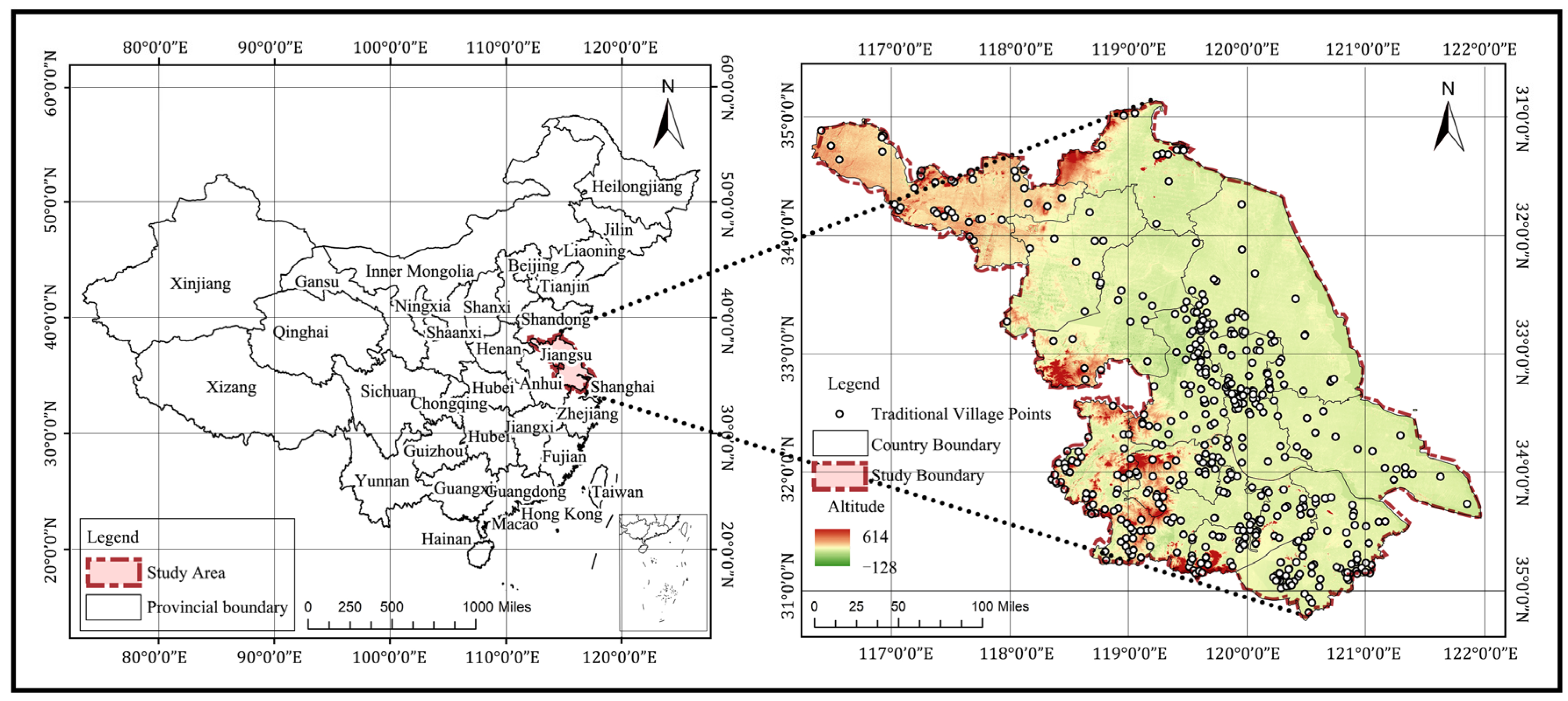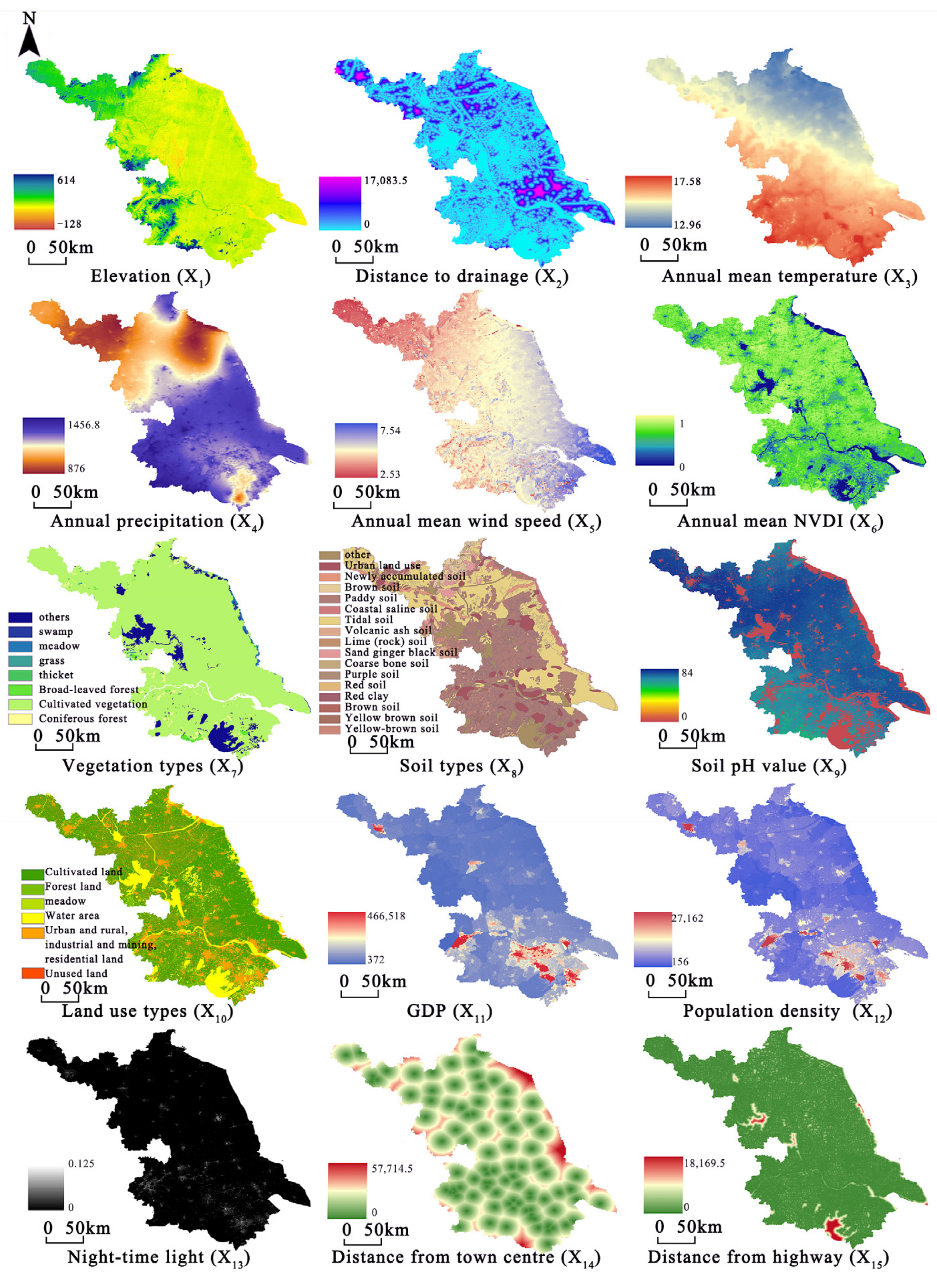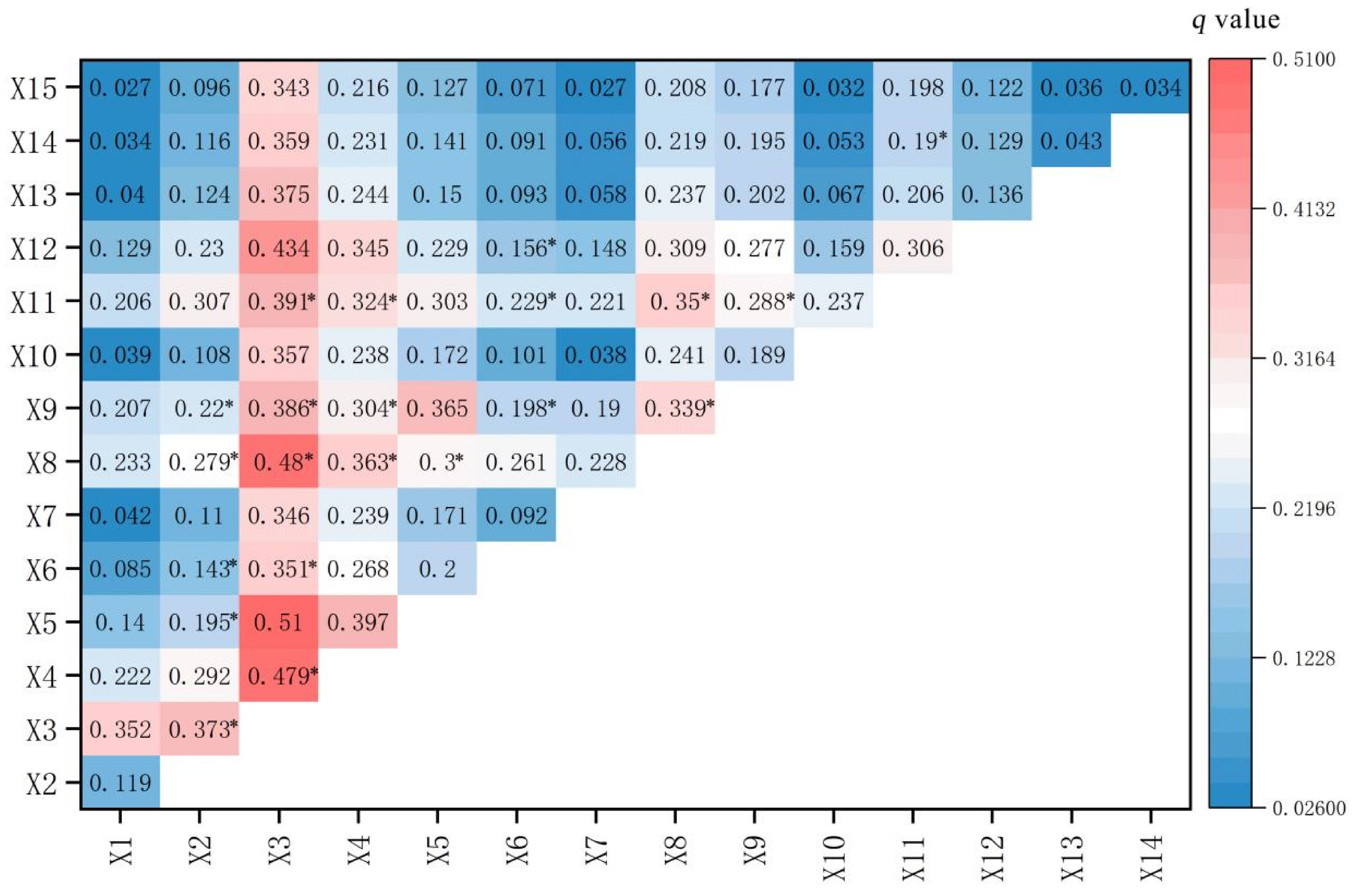Spatial Differentiation and Driving Factors of Traditional Villages in Jiangsu Province
Abstract
1. Introduction
2. Study Area and Data Source
2.1. Research Area
2.2. Indicator Selection and Data Source
3. Methodology
3.1. Spatial Distribution Characteristics Research Methods
3.1.1. Nearest Neighbor Index Calculation
3.1.2. Voronoi Diagram Analysis
3.1.3. Spatial Autocorrelation Analysis
3.1.4. Kernel Density Estimation
3.2. Geodetector
3.2.1. Optimal Parameter Selection
3.2.2. Factor Detection and Interactive Detection
3.2.3. Risk Detection
4. Results and Analysis
4.1. Characteristics of Agglomeration Distribution
4.2. Spatial Distribution of Kernel Density
4.3. Spatial Autocorrelation Analysis
4.4. Driving Force Detection of Spatial Heterogeneity
4.4.1. Determination of Driving Factors and Selection of Optimal Parameters
4.4.2. Geodetector Results and Analysis
- (1)
- Dominant factors
- (2)
- Interactive factors
- (3)
- Risk detection
5. Discussion
5.1. Summary
5.2. Limitations
5.3. Prospects for Future Research
6. Conclusions
Author Contributions
Funding
Informed Consent Statement
Data Availability Statement
Conflicts of Interest
References
- Hu, Y.; Chen, S.; Cao, W.; Cao, C. The concept and cultural connotation of traditional villages. Urban Dev. Stud. 2014, 1, 10–13. [Google Scholar]
- Notice on the Implementation of the Sixth Batch of Surveys and Recommendations for Chinese Traditional Villages by the Office of the Ministry of Housing and Urban-Rural Development, etc. Available online: https://www.mohurd.gov.cn/gongkai/zhengce/zhengcefilelib/202207/20220725_767319.html (accessed on 29 June 2023).
- Trewartha, G.T. Types of rural settlement in colonial America. Geogr. Rev. 1946, 36, 568–596. [Google Scholar] [CrossRef]
- Clark, J.K.; Mcchesney, R.; Munroe, D.K. Spatial characteristics of exurban settlement pattern in the United States. Landsc. Urban Plan. 2009, 90, 178–188. [Google Scholar] [CrossRef]
- Ristić, D.; Vukoičić, D.; Milinčić, M. Tourism and sustainable development of rural settlements in protected areas-Example NPKopaonik (Serbia). Land Use Policy 2019, 89, 104231. [Google Scholar] [CrossRef]
- Li, J.; Chu, J.; Wang, Y.; Ma, M.; Yang, X. Reconstruction of Traditional Village Spatial Texture Based on Parametric Analysis. Wirel. Commun. Mob. Comput. 2022, 6, 151421. [Google Scholar] [CrossRef]
- Liu, L.; Liu, Z. Delineation of traditional village boundaries: The case of Haishangqiao village in the Yiluo River Basin, China. PLoS ONE 2022, 17, e0279042. [Google Scholar] [CrossRef]
- Lin, M.; Jian, J.; Yu, H.; Zeng, Y.; Lin, M. Research on the spatial pattern and influence mechanism of industrial transformation and development of traditional villages. Sustainability 2021, 16, 8898. [Google Scholar] [CrossRef]
- Liang, B.; Xiao, D.; Tao, J.; Ji, J.; Zhuo, X.; Huang, Y. The temporal and spatial pattern and evolution of the distribution of traditional Hakka villages in Ganzhou. Econ. Geogr. 2018, 38, 196–2003. [Google Scholar]
- Chen, X.; Xie, W.; Li, H. The spatial evolution process, characteristics and driving factors of traditional villages from the perspective of the cultural ecosystem: A case study of Chengkan Village. Habitat Int. 2020, 104, 102250. [Google Scholar] [CrossRef]
- Liu, X.; Huang, Y.; Xiang, H.; Zhang, C.; Chen, J.; Xiao, D. Optimization strategies for the management mechanisms of conservation and utilization in traditional Chinese villages based on relevance analyses of performance evaluation. J. Asian Archit. Build. Eng. 2023, 22, 1699–1713. [Google Scholar] [CrossRef]
- Prevolšek, B.; Maksimović, A.; Puška, A.; Pažek, K.; Žibert, M.; Rozman, Č. Sustainable development of ethno-villages in Bosnia and Herzegovina: A multi criteria assessment. Sustainability 2020, 4, 1399. [Google Scholar] [CrossRef]
- Kim, G.W.; Kang, W.; Park, C.R.; Lee, D. Factors of spatial distribution of Korean village groves and relevance to landscape conservation. Landsc. Urban Plan. 2018, 176, 30–37. [Google Scholar] [CrossRef]
- Gao, X.; Li, Z.; Sun, X. Relevance between Tourist Behavior and the Spatial Environment in Huizhou Traditional Villages—A Case Study of Pingshan Village, Yi County, China. Sustainability 2023, 15, 5016. [Google Scholar] [CrossRef]
- Lv, W.; Tang, J. Studies of ancient townscape regeneration through the articulation of the space syntax methodology. Cogent. Eng. 2019, 1, 1603261. [Google Scholar] [CrossRef]
- Jiang, Y.; Li, N.; Wang, Z. Parametric Reconstruction of Traditional Village Morphology Based on the Space Gene Perspective—The Case Study of Xiaoxi Village in Western Hunan, China. Sustainability 2023, 15, 2088. [Google Scholar] [CrossRef]
- Xu, Q.; Wang, J. Recognition of values of traditional villages in Southwest China for sustainable development: A case study of Liufang Village. Sustainability 2020, 14, 7569. [Google Scholar] [CrossRef]
- Bian, J.; Chen, W.; Zeng, J. Spatial Distribution Characteristics and Influencing Factors of Traditional Villages in China. Int. J. Environ. Res. Public Health 2022, 19, 4627. [Google Scholar] [CrossRef]
- Su, H.R.; Wang, Y.W.; Zhang, Z.; Dong, W. Characteristics and Influencing Factors of Traditional Village Distribution in China. Land 2022, 11, 1631. [Google Scholar] [CrossRef]
- Wang, Q.; Liu, W.; Mao, L. Spatial Evolution of Traditional Village Dwellings in Heilongjiang Province. Sustainability 2023, 15, 5330. [Google Scholar] [CrossRef]
- Ma, H.; Tong, Y. Spatial differentiation of traditional villages using ArcGIS and GeoDa: A case study of Southwest China. Ecol. Inform. 2022, 68, 101416. [Google Scholar] [CrossRef]
- Jia, A.; Liang, X.; Wen, X.; Yun, X.; Ren, L.; Yun, Y. GIS-Based Analysis of the Spatial Distribution and Influencing Factors of Traditional Villages in Hebei Province, China. Sustainability 2023, 15, 9089. [Google Scholar] [CrossRef]
- Wei, D.; Wang, Z.; Zhang, B. Traditional Village Landscape Integration Based on Social Network Analysis: A Case Study of the Yuan River Basin in South-Western China. Sustainability 2021, 13, 13319. [Google Scholar] [CrossRef]
- Li, S.; Song, Y.; Xu, H.; Li, Y.; Zhou, S. Spatial Distribution Characteristics and Driving Factors for Traditional Villages in Areas of China Based on GWR Modeling and Geodetector: A Case Study of the Awa Mountain Area. Sustainability 2023, 15, 3443. [Google Scholar] [CrossRef]
- Katsue, F. Sustainability of terraced paddy fields in traditional satoyama landscapes of Japan. J. Environ. Manag. 2017, 202, 543–549. [Google Scholar]
- Li, M.; Ouyang, W.; Zhang, D. Spatial Distribution Characteristics and Influencing Factors of Traditional Villages in Guangxi Zhuang Autonomous Region. Sustainability 2023, 15, 632. [Google Scholar] [CrossRef]
- Chen, W.X.; Yang, L.Y.; Wu, J.H.; Wu, J.H.; Wang, G.Z.; Bian, J.J.; Zeng, J.; Liu, Z.L. Spatio-temporal characteristics and influencing factors of traditional villages in the Yangtze River Basin: A Geodetector model. Herit. Sci. 2023, 11, 111. [Google Scholar] [CrossRef]
- Wang, J.; Xu, C. Geodetector. Principle and prospect. Acta Geogr. Sin. 2017, 72, 116–134. [Google Scholar]
- Song, Y.; Wang, J.; Ge, Y.; Xu, C. An optimal parameters-based geographical detector model enhances geographic characteristics of explanatory variables for spatial heterogeneity analysis: Cases with different types of spatial data. GIScience Remote Sens. 2020, 57, 593–610. [Google Scholar] [CrossRef]
- Liu, T.; Wang, S.; Wang, Z.; Li, B.; Guo, S.; Wei, B. Data science based landscape ecology for traditional village landscape protection. Int. J. Comput. Appl. Technol. 2021, 65, 290–300. [Google Scholar] [CrossRef]
- Wu, C.; Chen, M.; Zhou, L.; Liang, X.; Wang, W. Identifying the spatiotemporal patterns of traditional villages in China: A multiscale perspective. Land 2020, 9, 449. [Google Scholar] [CrossRef]
- Li, C.; Wu, Y.; Gao, L.; Wu, Y.; Zheng, K.; Li, C. Spatial Differentiation and Driving Factors of Rural Settlement in Plateau Lake: A Case Study of the Area around the Erhai. Ecomomic Geogr. 2022, 42, 220–229. [Google Scholar]
- Chen, K.; Ding, K.Y.; Zhang, X.C. Analysis of spatio-temporal dynamics and driving forces of vegetation cover in the Fuyang River Basin based on the geographic detector. Earth Sci. Front. 2023, 6, 1–15. [Google Scholar]
- Ma, R.; Yang, S. The Effect of Social Network on Controlled-Release Fertilizer Use: Evidence from Rice Large-Scale Farmers in Jiangsu Province, China. Sustainability 2023, 15, 2982. [Google Scholar] [CrossRef]
- 502 Provincial-level Traditional Villages Are under Unified Protection. Available online: http://www.jiangsu.gov.cn/art/2023/6/4/art_60085_10913243.html (accessed on 29 June 2023).
- Wang, W.; Wu, Q.; Hu, C. Analysis of spatial distribution characteristics and Influencing factors of traditional villages in Jiangsu Province. J. Xi’an Univ. Archit. Technol. (Soc. Sci. Ed.) 2023, 42, 32–39. [Google Scholar]
- Tian, Y.; Kong, X.; Liu, Y. Combining weighted daily life circles and land suitability for rural settlement econstruction. Habitat Int. 2018, 76, 1–9. [Google Scholar] [CrossRef]
- He, Y.; Wang, W.; Chen, Y.; Yan, H. Assessing spatio-temporal patterns and driving force of ecosystem service value in the main urban area of Guangzhou. Sci. Rep. 2021, 11, 1–18. [Google Scholar] [CrossRef]





| Category | Dataset and Time | Resolution | Data Source |
|---|---|---|---|
| Research sample | Poi of the traditional village (2012–2023) | - | http://www.chuantongcunluo.com/ (accessed on 1 May 2023) |
| Geomorphic data | DEM (2018) | 30 m | http://www.gscloud.cn/ (accessed on 1 May 2023) |
| Drainage map (2018) | - | https://www.webmap.cn/ (accessed on 1 May 2023) | |
| Meteorological data | Annual mean temperature (2022) | 1 km | http://www.geodata.cn/ (accessed on 1 May 2023) |
| Annual precipitation (2022) | 1 km | http://www.geodata.cn/ (accessed on 1 May 2023) | |
| Annual mean wind speed (2020) | 1 km | http://www.geodata.cn/ (accessed on 1 May 2023) | |
| Ecological data | NDVI (2019) | 500 m | http://ladsweb.nascom.nasa.gov/data/search.html (accessed on 1 May 2023) |
| Vegetation types (2018) | 500 m | http://www.geodata.cn/ (accessed on 1 May 2023) | |
| Soil types (2018) | 250 m | http://www.geodata.cn/ (accessed on 1 May 2023) | |
| Soil pH value (2020) | 250 m | http://www.geodata.cn/ (accessed on 1 May 2023) | |
| Socioeconomic data | Land use/cover (2020) | 30 m | http://www.geodata.cn/ (accessed on 1 May 2023) |
| GDP (2019) | 1 km | http://www.resdc.cn/ (accessed on 1 May 2023) | |
| China population in grid transformation (2019) | 1 km | http://www.resdc.cn/ (accessed on 1 May 2023) | |
| Night light data (2018) | 130 m | http://www.hbeos.org.cn/ (accessed on 1 May 2023) | |
| Town center poi data (2023) | - | https://www.webmap.cn/ (accessed on 1 May 2023) | |
| Road map (2018) | - | https://www.web-map.cn/ (accessed on 1 May 2023) |
| Criterion of Interval | Interaction |
|---|---|
| q(X1∩X2) < Min[q(X1),q(X2)] | Nonlinear weakening |
| Min[q(X1),q(X2)] < q(X1∩X2) < Max[q(X1),q(X2)] | Single-factor nonlinear weakening |
| q(X1∩X2) > Max[q(X1),q(X2)] | Two-factor enhancement |
| q(X1∩X2) = q(X1) + q(X2) | Independence |
| q(X1∩X2) > q(X1) + q(X2) | Nonlinear enhancement |
| Indicators | Value | Zscore |
|---|---|---|
| ANN | 0.656 | −14.748 |
| CV | 162.19% | - |
| Moran’s I | 0.570 | 7.066 |
| Evaluation Index | Suitable Range (Type) | Mean Kernel Density (PCS/10,000 km²) |
|---|---|---|
| Elevation (X1) | 122~154 m | 0.008591 |
| Distance to drainage (X2) | 0~504 m | 0.006285 |
| Annual mean temperature (X3) | 17~17.6 °C | 0.008107 |
| Annual precipitation (X4) | 1330~1456.8 billion m³ | 0.007363 |
| Annual mean wind speed (X5) | 0.549~0.565 m/s | 0.007134 |
| Annual mean NVDI (X6) | 0.0506~0.199 (normalized value) | 0.006680 |
| Vegetation types (X7) | Cultivated vegetation | 0.006838 |
| Soil types (X8) | Take off the latent paddy soil | 0.006962 |
| Soil pH value (X9) | 5.63 < pH < 6.32 | 0.007248 |
| Land use types (X10) | Cultivated land | 0.011355 |
| GDP (X11) | 8510~204,000 CNY/km−2 | 0.008222 |
| Population density (X12) | 2.32~3.91 thousand people/km−2 | 0.008087 |
| Night light (X13) | 0.0095~0.0125 W/(m2·sr·μm) | 0.008528 |
| Distance from town center (X14) | 247~4790 m | 0.005185 |
| Distance from highway (X15) | 10,100~15,200 m | 0.006110 |
Disclaimer/Publisher’s Note: The statements, opinions and data contained in all publications are solely those of the individual author(s) and contributor(s) and not of MDPI and/or the editor(s). MDPI and/or the editor(s) disclaim responsibility for any injury to people or property resulting from any ideas, methods, instructions or products referred to in the content. |
© 2023 by the authors. Licensee MDPI, Basel, Switzerland. This article is an open access article distributed under the terms and conditions of the Creative Commons Attribution (CC BY) license (https://creativecommons.org/licenses/by/4.0/).
Share and Cite
Zhang, Q.; Wang, J. Spatial Differentiation and Driving Factors of Traditional Villages in Jiangsu Province. Sustainability 2023, 15, 11448. https://doi.org/10.3390/su151411448
Zhang Q, Wang J. Spatial Differentiation and Driving Factors of Traditional Villages in Jiangsu Province. Sustainability. 2023; 15(14):11448. https://doi.org/10.3390/su151411448
Chicago/Turabian StyleZhang, Qinghai, and Jiabei Wang. 2023. "Spatial Differentiation and Driving Factors of Traditional Villages in Jiangsu Province" Sustainability 15, no. 14: 11448. https://doi.org/10.3390/su151411448
APA StyleZhang, Q., & Wang, J. (2023). Spatial Differentiation and Driving Factors of Traditional Villages in Jiangsu Province. Sustainability, 15(14), 11448. https://doi.org/10.3390/su151411448








